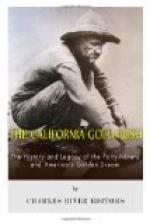At Nauvoo, on the eastern bank of the Mississippi, they built a really pretentious and beautiful city, and all but completed a temple that was, from every account, creditable. However, their arrogant relations with their neighbors and the extreme isolation in which they held themselves soon earned them the dislike and distrust of those about them. The practice of polygamy had begun, although even to the rank and file of the Mormons themselves the revelation commanding it was as yet unknown. Still, rumors had leaked forth. The community, already severely shocked in its economic sense, was only too ready to be shocked in its moral sense, as is the usual course of human nature. The rather wild vagaries of the converts, too, aroused distrust and disgust in the sober minds of the western pioneers. At religious meetings converts would often arise to talk in gibberish—utterly nonsensical gibberish. This was called a “speaking with tongues,” and could be translated by the speaker or a bystander in any way he saw fit, without responsibility for the saying. This was an easy way of calling a man names without standing behind it, so to speak. The congregation saw visions, read messages on stones picked up in the field—messages which disappeared as soon as interpreted. They had fits in meetings, they chased balls of fire through the fields, they saw wonderful lights in the air, in short they went through all the hysterical vagaries formerly seen also in the Methodist revivals under John Wesley.
Turbulence outside was accompanied by turbulence within. Schisms occurred. Branches were broken off from the Church. The great temporal power and wealth to which, owing to the obedience and docility of the rank and file, the leaders had fallen practically sole heirs, had gone to their heads. The Mormon Church gave every indication of breaking up into disorganized smaller units, when fortunately for it the prophet Joseph Smith and his brother Hyrum were killed by a mob. This martyrdom consolidated the church body once more; and before disintegrating influences could again exert themselves, the reins of power were seized by the strong hand of a remarkable man, Brigham Young, who thrust aside the logical successor, Joseph Smith’s son.




